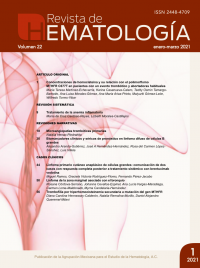Hyperhomocysteinemia thrombophilia secondary to MTHFR gene mutation.
Rev Hematol Mex. 2021; 22 (1): 56-61. https://doi.org/10.24245/rev_hematol.v22i1.4956
Diana Carolina Hennessey-Calderón,1 Natalia Remolina-Murillo,1 Daniel Alejandro Queremel-Milani2
1 Departamento de Medicina Interna,
Universidad El Bosque, Bogotá, DC, Colombia.
2 Universidad de los Andes, Bogotá, DC, Colombia.
Resumen
ANTECEDENTES: La formación de un coágulo dentro del lumen de cualquier vaso sanguíneo (arterial o venoso) se conoce como trombosis. Los principales factores descritos en la aparición de trombosis son hipercoagulabilidad, estasis sanguínea y daño endotelial (tríada de Virchow). Sin embargo, la enfermedad trombótica es de origen multifactorial, por lo que se requiere un análisis exhaustivo para obtener el diagnóstico y tratamiento adecuados.
CASO CLÍNICO: Paciente femenina de 79 años que padeció necrosis progresiva de tres ortejos del pie izquierdo, sin evidencia de cualquier otro daño vascular significativo previo o concomitante, que, por su desarrollo clínico, fue un desafío diagnóstico y requirió intervención multidisciplinaria. Se encontró un cuadro de hiperhomocisteinemia secundaria a mutación del gen MTHFR.
CONCLUSIONES: La enfermedad trombótica arterial y venosa y la hiperhomocisteinemia tiene múltiples causas, en esta última los determinantes no genéticos actúan principalmente alterando las concentraciones sanguíneas de vitaminas del complejo B.
PALABRAS CLAVE: Hiperhomocisteinemia; trombosis; trombofilia; mutación del gen MTHFR.
Abstract
BACKGROUND: The formation of a clot within the lumen of any blood vessel (arterial or venous) is known as thrombosis. The main factors described in the development of thrombosis are hypercoagulability, blood stasis and endothelial injury (Virchow’s triad). Nonetheless, the etiology of thrombotic disease is multifactorial, which requires a thorough analysis to obtain the appropriate diagnosis and treatment.
CLINICAL CASE: A 79-year-old female patient who developed progressive necrosis from the toes of the left foot, without evidence of any significant other previous or concomitant vascular damage, which, due to its clinical development, was a diagnostic challenge and required multidisciplinary intervention. Finding a hyperhomocysteinemia secondary to a MTHFR gene mutation.
CONCLUSIONS: Arterial and venous thrombotic disease and hyperhomocysteinemia have multiple causes, in the latter, non-genetic determinants act mainly by altering blood concentrations of B complex vitamins.
KEYWORDS: Hyperhomocysteinemia; Thrombosis; Thrombophilia; MTHFR gene mutation.
Recibido: enero 2021
Aceptado: marzo 2021
Este artículo debe citarse como: Hennessey-Calderón DC, Remolina-Murillo N, Queremel-Milani DA. Trombofilia por hiperhomocisteinemia secundaria a mutación del gen MTHFR. Hematol Méx. 2021; 22 (1): 56-61.

